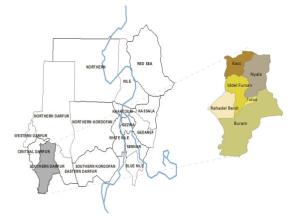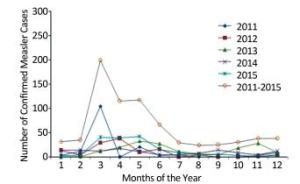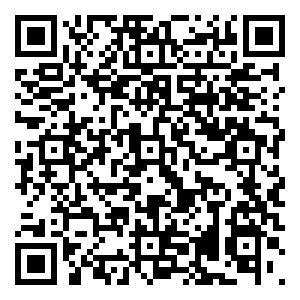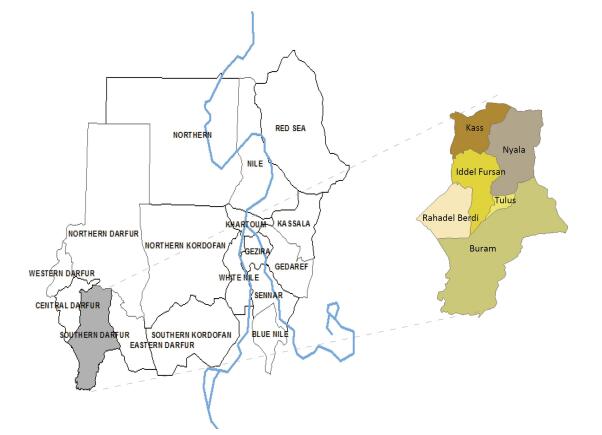-
Measles is a highly contagious viral disease and is one of the leading causes of vaccine-preventable deaths in young children globally[1]. The disease is transmitted mainly by droplets through the nose, mouth or throat of infected persons and presents with fever and generalized rash, accompanied by a cough, coryza, and conjunctivitis. The implementation of vaccination programs against measles constituted a major public health intervention, and has dramatically reduced the morbidity and mortality globally[2]. However, measles continues to be one of the leading causes of vaccine-preventable deaths in children less than five years of age worldwide, especially in developing countries[3]. In early of 2009, measles vaccine was extensively used throughout Africa, and the incidence was reduced[4].
Conversely, within the period of 2014 to 2015, more than 1, 600 suspected measles cases were reported and 710 cases were confirmed of measles from 23 localities in 12 states of Sudan. Thus, Darfur has experiences ongoing conflict that created a vulnerable population with limited access to health care services, shortage of food, and other necessities. The report shows one of the most affected states is West Darfur, with most of the cases among the gold mining workers. New cases are reported from North Darfur where the situation is compounded by internal displacement. Ongoing measles transmission among the camps and in Internally Displaced Persons (IDPs) and neighboring communities in Darfur led to a region-wide measles vaccination campaign[5].
Recently, the World Health Organization (WHO) sub-office in Nyala Southern Darfur in collaboration with the ministry of health Nyala, conducted a surveillance system for measles; thus, cases were identified through disease notifiable system in different health center in the areas. However, little was reported about the dynamics and epidemiology of measles outbreaks and the measles surveillance system in South Darfur state. This research effort provides useful information of the epidemiological profile of measles cases in Southern Darfur state, Sudan, between 2011 to 2015.
Measles surveillance data were collected from Southern Darfur State, Sudan. Southern Darfur State borders with Northern Darfur in the north, Central Darfur state to the West and the Central African Republic to the south-west, Northern Bahr el Ghazal and Western Bahr el Ghazal in South, and Eastern Darfur in the East part of the state. South Darfur is one of the five states that made up the region of Darfur in the western part of Sudan and Nyala is the capital of the state. It had an area of 127, 300 square kilometers (49, 200 sq mi) and an estimated population of approximately 4, 069, 300 (2008 est.). South Darfur has total 11 hospitals, 17 health centers, 1 ministry of interior affair hospital, and 4 private Sector Hospitals. Among them, Nyala Teaching Hospital was the largest hospitals in Southern Darfur state.
Therefore, Measles cases during 1st January 2011 to 31st December 2015 were analyzed. The areas were divided into six health zone including Nyala, Iddel Fursan, Tulus, Buram, Rahad Elberdi and Kass according to the health system (Figure 1).

Figure 1. Map of Sudan and geographic location of South Darfur State with 6 health zone (Nyala, Kass, Iddel Fursan, Rahad Elberdi, Tulus, and Buram).
In total, 511 notified cases were eligible for inclusion. Data of eligible children living in Darfur transmitted locally in primary health care center in South Darfur state were included. Basic demographic information collected were age, sex, residency status, number of vaccination dose (1 or 2 dose), time of vaccination cases and the source of measles identifications units (active research, campaign, community, health center, hospital, and private hospital). Measles cases were defined as suspected, Laboratory confirmed, EPI-Linked, clinically compatible and discarded cases were defined according to World Health Organization (WHO) guidelines[6]. The protocol for this investigation was approved by Ministry of Health, South Darfur State, Sudan.
Descriptive measles data are presented as a percentage. A chi-square test was used to assess the difference in vaccination status with study variables. All surveillance data were analyzed using SPSS software, (version 20.0; SPSS Inc., Chicago, IL). P-value < 0.05 was considered statistically significant.
The results showed that the most measles cases (58.1%) were identified in Nyala city the capital of Southern Darfur State and in Rahad Elberdi health zone 29.7%. Among the cases 43.4% were males, and 56.6% were females, 47.7% were children under five years old. Vaccination coverage among the cases was 13.9% for one dose, and 83.0% of children do not receive any dose of measles vaccine. About 8.0% of children received the vaccine through measles campaign, and 5.3% used child vaccination card, while 67.7% of children do not receive the final vaccine. Although 4.3% of the children were not receiving measles vaccine due to security reasons in the area. The hospital was an important source of information for the measles cases 29.4%, followed by measles active research unit 27.2%, and community base 19.0% (Table 1).
Table 1. Socio-demographic Characteristics of Suspected Measles Cases in South Darfur State, 2011-2015
Characteristics Number of Confirmed Measles Cases (%) Gender Male 222 (43.4) Female 289 (56.6) Health zone Nyala 297 (58.1) Iddel Fursan 15 (2.9) Tulus 10 (2.0) Buram 20 (3.9) Rahad Elberdi 152 (29.7) Kass 17 (3.3) Age (year) < 1 41 (8.0) 1-4 203 (39.7) 5-9 95 (18.6) 10-14 57 (11.2) ≥ 15 115 (22.5) Source of measles identifications Active search 139 (27.2) Campaign 3 (0.6) Community 97 (19.0) Health center 86 (16.8) Hospital 150 (29.4) Other sources 15 (2.9) Private 21 (4.1) Number of vaccination does 0 424 (83.0) 1 71 (13.9) ≥ 2 16 (3.1) Ways, how/where vaccination are offered Campaign 41 (8.0) Due to security status 22 (4.3) Routine by card 27 (5.3) Routine by hits 19 (3.7) Unvaccinated 402 (78.7) Confirmed measles cases by year 2011 147 (28.8) 2012 110 (21.5) 2013 116 (22.7) 2014 51 (10.0) 2015 87 (17.0) Measles cases classification Measles Compatible 4 (0.8) Measles EPI-Linked 205 (40.1) Measles Lab-confirmed 247 (48.3) Rubella lab-confirmed 55 (10.8) The results indicate that region and age groups is significantly associated with measles diseases. Statistically significant differences in vaccination status were reported by health zones (χ2= 43.31, P < 0.0001), and age group categories (χ2= 25.80, P < 0.0001) as presented in (Table 2).
Table 2. Measles Vaccination Status by Region, Gender and Age Groups in South Darfur State, 2011-2015
Characteristics Total No Vaccinated, n (%) Vaccinated, n (%) χ2 P-Value Gender Male 222 178 (80.2) 44 (19.8) 2.170 0.141 Female 289 246 (85.0) 43 (14.9) Age (year) < 1 41 37 (90.2) 4 (9.8) 25.80 < 0.0001 1-4 203 161 (79.3) 42 (20.7) 5-9 95 69 (72.6) 26 (27.4) 10-14 57 46 (80.7) 11 (19.3) ≥ 15 115 111 (96.5) 4 (3.5) Health zone Kass 17 16 (94.1) 1 (5.9) 43.31 < 0.0001 Nyala 297 219 (73.7) 78 (26.3) Iddel Fursan 15 15 (100) 0 (0.0) Tulus 10 9 (90.0) 1 (10.0) Rahad Elberdi 152 146 (96.1) 6 (3.9) Buram 20 19 (95.0) 1 (5.0) The total number of suspected measles cases reported from 2011 to 2015 in Southern Darfur was similar to that of January and February of each year. The cases escalated in March and start declining in April, May, June, July, August, September, October, November, and December during the study period (Figure 2). In addition, the measles cases distribution within six health zone is presented in Table 3.
Table 3. Measles Cases by Region and Year in South Darfur State, Sudan, 2011-2015
Region/Year 2011 2012 2013 2014 2015 Total, n (%) Kass 0 11 0 0 6 17 (3.33) Nyala 46 50 99 45 57 297 (58.12) Iddel Fursan 9 6 0 0 0 15 (2.94) Tulus 0 0 9 1 0 10 (1.96) Rahad Elberdi 89 34 8 0 21 152 (29.75) Buram 3 9 0 5 3 20 (3.91) Measles is a major health problem worldwide, the disease can be eliminated considering its exclusively human reservoir, the lack of long-term carrier state for the virus and the availability of an effective and safe vaccine. The present study indicated that the most identified measles cases were in Nyala city the capital of Southern Darfur State, which has the highest population in Sudan after Khartoum the capital city of Sudan. Consistent with the previous studies males were more susceptible to measles compared with females[7-8].
The majority of measles cases occurred among children under five years old, is expected with relatively low vaccine coverage. Similar findings were reported in Iraq during the surveillance period in 2005 to 2010[9]and in Tianjin, China[7]. In our study, we found that children belonging to the age group '1-5 years' were most affected by measles compare with another age group. This finding was in agreement with Saudi national surveillance data for notified measles cases in 2006[9]. In addition, most measles cases have occurred among children aged 15 or greater than 15 years old. Similar results were indicated in Ethiopia during the period of 2007-2014[9]. Our investigation among vaccinated and unvaccinated measles cases indicated that age was associated with an increased risk of measles in the Southern Darfur. The suspected measles cases in Southern Darfur were increased from February to June and reach the peak in March, while decreased through July to January. Similarly, increasing and decreasing of measles cases from time to time and within different years was reported in various population[8]. In tropical zones, most cases of measles occur during the dry season, whereas in temperate zones, cases peaks during late winter and early spring in a Southern nation of Ethiopian countries[10], and the measles cases continue to be endemically transmitted in Darfur region.
The epidemiological study shows measles sources of information were range from high cases identified at hospitals, followed by active research units, and through health centers in the study area. Vaccination coverage was 13.9% for one dose and 3.1% more than or equal to two dose, while 83.0% of children did not receive any dose of measles vaccine. About 0.6% of children received the vaccine through measles campaign, and 5.3% used child vaccination card, while 78.7% of children do not receive the last vaccine dose coverage. The Expanded Program for Immunization (EPI) estimated that measles vaccination coverage in Sudan is about 63%[10]. In addition, not all children will receive measles vaccine. As a result, the number of susceptible individuals may accumulate over time with the potential for outbreaks to occur. The study concludes that among the measles cases, the most cases were presented in the capital city Nyla, were unvaccinated or with unknown vaccination status, and children under five years are more subjected to measles. Finally, many efforts were needed to support hospital, health center and community as sources of identification and treatment of cases of measles diseases, prevention, and control in the study area. Moreover, enhance governmental security program in the area, will assist in measles coverage vaccine in the study area in particular among venerable age group less than five years old.
We highly appreciate the outstanding staff of the ministry of health, immunization officers, surveillance medical officers, and measles laboratory staff throughout the different health zone in South Darfur State, Sudan, for making this data available for the current study.
The authors declared no potential conflicts of interest with respect to the research, authorship, and/or publication of this article.
doi: 10.3967/bes2017.123
-
Abstract: Case-based surveillance measles data was defined according to World Health Organization (WHO) guidelines. A total of 511 measles cases were studied from 2011 to 2015 in Southern Darfur State, Sudan and 58.1% of cases were confirmed from Nyala city. About 43.4% of cases were males, 56.6% of cases were female, and 47.7% were children under five years old. Similarity, within February to June, the cases increased by 8.0% in children vaccinated through measles campaign, and 5.3% in children that used child vaccination card and 78.7% in unvaccinated one. The epidemiologically linked (EPI-Linked) measles cases declined from 2011 to 2015; consequently, Measles still remain to be a significant challenge in south Darfur state, Sudan.
-
Table 1. Socio-demographic Characteristics of Suspected Measles Cases in South Darfur State, 2011-2015
Characteristics Number of Confirmed Measles Cases (%) Gender Male 222 (43.4) Female 289 (56.6) Health zone Nyala 297 (58.1) Iddel Fursan 15 (2.9) Tulus 10 (2.0) Buram 20 (3.9) Rahad Elberdi 152 (29.7) Kass 17 (3.3) Age (year) < 1 41 (8.0) 1-4 203 (39.7) 5-9 95 (18.6) 10-14 57 (11.2) ≥ 15 115 (22.5) Source of measles identifications Active search 139 (27.2) Campaign 3 (0.6) Community 97 (19.0) Health center 86 (16.8) Hospital 150 (29.4) Other sources 15 (2.9) Private 21 (4.1) Number of vaccination does 0 424 (83.0) 1 71 (13.9) ≥ 2 16 (3.1) Ways, how/where vaccination are offered Campaign 41 (8.0) Due to security status 22 (4.3) Routine by card 27 (5.3) Routine by hits 19 (3.7) Unvaccinated 402 (78.7) Confirmed measles cases by year 2011 147 (28.8) 2012 110 (21.5) 2013 116 (22.7) 2014 51 (10.0) 2015 87 (17.0) Measles cases classification Measles Compatible 4 (0.8) Measles EPI-Linked 205 (40.1) Measles Lab-confirmed 247 (48.3) Rubella lab-confirmed 55 (10.8) Table 2. Measles Vaccination Status by Region, Gender and Age Groups in South Darfur State, 2011-2015
Characteristics Total No Vaccinated, n (%) Vaccinated, n (%) χ2 P-Value Gender Male 222 178 (80.2) 44 (19.8) 2.170 0.141 Female 289 246 (85.0) 43 (14.9) Age (year) < 1 41 37 (90.2) 4 (9.8) 25.80 < 0.0001 1-4 203 161 (79.3) 42 (20.7) 5-9 95 69 (72.6) 26 (27.4) 10-14 57 46 (80.7) 11 (19.3) ≥ 15 115 111 (96.5) 4 (3.5) Health zone Kass 17 16 (94.1) 1 (5.9) 43.31 < 0.0001 Nyala 297 219 (73.7) 78 (26.3) Iddel Fursan 15 15 (100) 0 (0.0) Tulus 10 9 (90.0) 1 (10.0) Rahad Elberdi 152 146 (96.1) 6 (3.9) Buram 20 19 (95.0) 1 (5.0) Table 3. Measles Cases by Region and Year in South Darfur State, Sudan, 2011-2015
Region/Year 2011 2012 2013 2014 2015 Total, n (%) Kass 0 11 0 0 6 17 (3.33) Nyala 46 50 99 45 57 297 (58.12) Iddel Fursan 9 6 0 0 0 15 (2.94) Tulus 0 0 9 1 0 10 (1.96) Rahad Elberdi 89 34 8 0 21 152 (29.75) Buram 3 9 0 5 3 20 (3.91) -
[1] World Health Organization, 2014. World Health Organization fact sheet on measles. Available at: http://www.who.int/mediacentre/factsheets/fs286/en/index.html. [2014-5-15] [2] Moss WJ, Griffin DE. Measles. Lancet, 2012; 379, 153-64. doi: 10.1016/S0140-6736(10)62352-5 [3] World Health Organization /UNICEF Joint Statement on Global plan for reducing measles mortality 2006-2010. http://www.who.int/vaccines-documents/DocsPDF06/WHO_IVB_05_11.pdf. [2010-11-30] [4] Centers for Disease Control and Prevention. Global measles mortality, 2000-2008. Morb Mortal Wkly Rep, 2009; 58, 1321-6. [5] World Health Organization. Setting up an early warning system for epidemic-prone diseases in the Darfur humanitarian crisis. Wkly Epidemiol Rec, 2004; 79, 246-7. [6] World Health Organization. Guidelines for measles and rubella outbreak investigation and response in the WHO European Region. http://www.euro.who.int/_-data/assets/pdf_file/0003/217164/OutbreakGuidelines-updated.pdf. [2017-10-14] [7] Wang X, Boulton ML, Montgomery JP, et al. The epidemiology of measles in Tianjin, China, 2005-2014. Vaccine, 2015; 33, 6186-19. doi: 10.1016/j.vaccine.2015.10.008 [8] Jasem J, Marof K, Nawar N, et al. Epidemiological analysis of measles and evaluation of measles surveillance system performance in Iraq, 2005-2010. Int J Infect Dis, 2012; 16, 166-71. https://www.sciencedirect.com/science/article/pii/S1201971211002372 [9] Ibrahim SA, Mustafa OM, Mukhtar MM, et al. Measles in suburban Khartoum: an epidemiological and clinical study. Trop Med Int Health, 2002; 7, 442-9. doi: 10.1046/j.1365-3156.2002.00884.x [10] Getahun M, Beyene B, Ademe A, et al. Epidemiology of laboratory confirmed measles virus cases in the southern nations of Ethiopia, 2007-2014. BMC Infect Dis, 2017; 17, 87. doi: 10.1186/s12879-017-2183-5 -




 下载:
下载:





 Quick Links
Quick Links